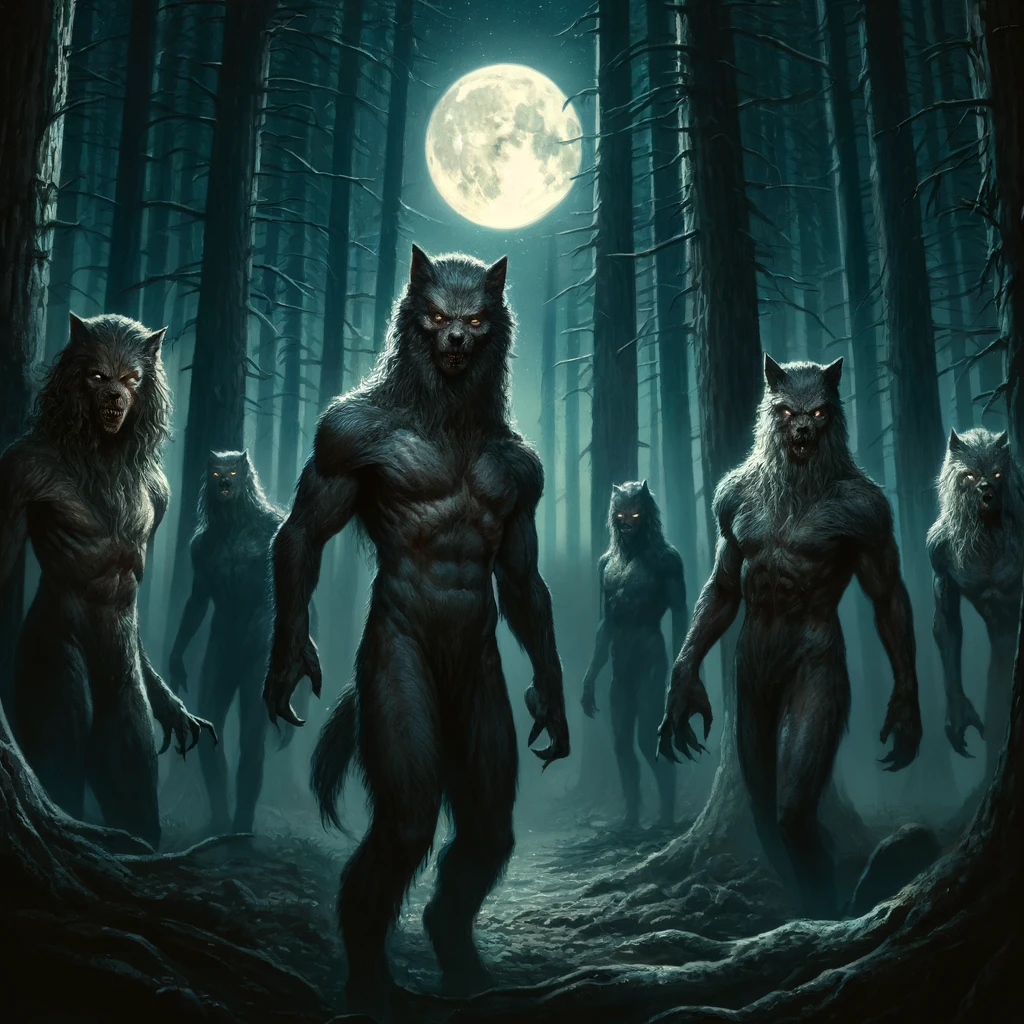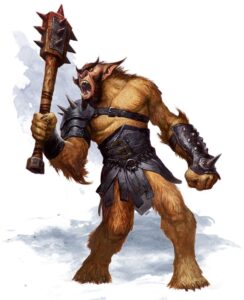
While typified by the ubiquitous werewolf, in truth there are several varieties of lycanthrope, each of which transform into a different beast. Whether their transformation is voluntary and controlled, or a painful ordeal linked to the lunar cycle, depends on the character of the lycanthrope. Over the years, many a scholar has attempted to lead the charge in renaming the creatures 'therianthropes' to properly reflect their diverse forms (some of these scholars were, reportedly, non-werewolf lycanthropes themselves), but each has been ignored or shouted down.
Different types of lycanthrope, as a rule, mistrust if not outright despise one another. While rival groups are generally separated by preferences in territory or prey, conflicts can break out where they overlap. A shifting hierarchy exists between lycanthropes which, for centuries, has been topped by the numerous and ruthless werewolf. While enmities run deep between groups, different lycanthropes have been known to join together in times of extreme threat to their species as a whole. In such times, packs meet on neutral ground, and ancient tenets forbid the harming of fellow lycanthropes, tenets even the most bloodthirsty or vengeful werewolf would never think to break. The most common enemy faced in this way is the vampire, for whom all lycanthropes share an ingrained hatred.
Further fracturing lycanthropes is the ideological schism between those that embrace the condition, allowing the beast to bleed into their own personality, and so allowing them to control their physical change, and those that resist it, preventing the beast from affecting their personality, but releasing any level of control over the change that comes upon them at the time of the full moon. Embracers tend to feel some level of rivalry towards each other, and jostle to be top of the pecking order, while viewing suppressors as prissy fools missing out on the opportunities afforded to them.
Suppressors often view each other with distrust and caution, always questioning whether their fellows are taking as much care as they possibly could to control themselves, and view embracers as mindless brutes.
In its humanoid form, a lycanthrope might bear no sign of its condition. Suppressors may appear a little sickly and sleep deprived around the time of the full moon, but otherwise resemble any other member of their race. Embracers tend to undergo some level of physical change to reflect the bestial nature which they have allowed to blend into their own life. Excessive body hair or claw-like nails are classic signs, but more obvious can be yellow, slitted, or otherwise bestial eyes, which reflect light in the dark.
By all accounts, transformation is an agonizingly painful process, as bones and muscle warp under the skin, growing or shrinking to the proportions of the beast. With practice, embracers can accelerate the process, in some cases shifting form entirely over the course of a single bound. For suppressors, however, the change is a thing to be dreaded each month, with their resistance only drawing out the experience and heightening the pain.
Lycanthropes carry a fearsome reputation, understandably tinged with a considerable level of paranoia. Much of the folklore surrounding them centers around discovering hidden lycanthropes, and can quickly fuel outbreaks of hysteria in superstitious areas where one is suspected. In such times, it is best to go clean-shaven, for even the most mildly hirsute individual may find themselves under close scrutiny (dwarves, in particular, suffer during these times, due to their social taboos concerning beard-cutting). Some traveling 'wolf-finders' may indeed be motivated by altruism, and may even know a handful of helpful rituals to seek out and aid accursed creatures, but many more are shameless charlatans or woefully misguided. A common practice is cutting the accused with a steel blade, with it being widespread knowledge that lycanthropes are immune to common metals. However, not only does this give no indication of the type of lycanthrope discovered (though, in times of panic, any and all are branded as evil as the basest of them), it is easy to misdirect - swindlers might use blunted or retractable blades to cast suspicion upon an expedient target - or misunderstand, with some using silvered blades and expecting to see a pelt beneath the skin to betray the existence of a lycanthrope.
Some scholars theorize that the origin of the lycanthrope lies with their most hated enemy, the vampires. It is thought that, millennia ago, vampires experimented with imbuing some of their human 'livestock' with some measure of their own shape changing power. Whether by oversight or design, these experiments were able to spread their condition in the same manner as their master - the bite. This goes some way to explain why the most numerous form of lycanthrope is the werewolf (the wolf being a common vampiric form), as well as their hatred of vampires. Whether lycanthropes escaped, and later diverged into different forms, or the vampires originally created them in the forms we see today, is unknown.
Another proposed origin is the natural magic of druids, fey, or other such creatures. More capricious spirits are famed for unorthodox punishments against those who disrespect nature or transgress her laws, and it is possible that on one or more occasions, rather than stopping at punishing a single transgressor, an entire bloodline may have been cursed. Good lycanthropes do tend to feel a pull towards protecting the balance of the natural world, so it is possible we can look to nature's more traditional guardians for their beginnings.
As well as spreading through bites, the condition can also be inherited. While the offspring of two lycanthropes will almost certainly be one too, lycanthropy becomes diluted through generations of breeding with non-lycanthropes. While the child of a lycanthrope and a non-lycanthrope may retain most, if not all, of their bestial powers, their offspring may only be able to transform into less and less monstrous transitional forms and, after a few more generations, have only a slight predilection for rare meat as a mark of their legacy. Conversely, those with a lycanthrope far back in their ancestry may develop the condition seemingly from nowhere; their grandmother's grand mother's dalliance with a hairy stranger having been long forgotten. With no guidance from others of their kind, these lycanthropes often prove to be the most dangerous and unpredictable.
All lycanthropes share a deep taboo against breeding in animal form, but there are rare exceptions. The vast majority of such offspring will not come to term and, of those, few will survive to adulthood. Those that do, resemble a lycanthrope in beast form; an unusually intelligent, but otherwise unremarkable, animal. Very rarely, however, the offspring inherit a kind of reverse lycanthropy, allowing them to change temporarily into a humanoid form, though retaining the intellect and character of a beast.
Lycanthropes may be found within any humanoid society and, depending on the exact form of the affliction, may have little impact on the group as a whole. Good-natured lycanthropes, for example, will go out of their way to remove themselves to the wilderness, or arrange to be physically restrained, when the change comes upon them. On the other hand, many brutal murders or apparent attacks by wild beasts can be traced back to evil, or simply uncontrolled, lycanthropes. The vast majority of lycanthropes keep their condition secret due to the social stigma, uninformed myths, and often well deserved fear and suspicion from the general populace.
Conversely, within shamanistic societies, lycanthropes can attain positions of respect, even reverence. It is not unheard of to see tribes formed around lycanthropes acting as a spiritual advisor or even chieftain. Whether a lycanthrope uses their position to act for the good of the group, utilizing their powers in its defense, or perverts their course, demanding sacrifices to their appetites, depends on the individual in question. Regardless of their intentions, lycanthropes in these communities often choose not to infect those around them, whether due to a fear of losing their privileged position, a moral opposition to spreading their affliction, or a simple unwillingness to have to bother with any competition.
More commonly, lycanthropes band together with others of their kind both separate from greater civilization and secretly within it. Within society, lycanthropes may only meet in bestial form, and otherwise remain strangers, or may be closely linked (perhaps under the guise of mercenaries, thieves, or other professions which might explain their generally rougher appearance and demeanor). Outside of society, groups of lycanthropes exist more like animals or particularly savage bandits. Lycanthropes expelled from such a group, or left alone and unused to solitude, may spend the rest of their lives in beast form among their kin. Unusually aggressive wolf packs, or the sudden appearance of man-eating panthers, can often be traced back to such suddenly isolated lycanthropes taking over a local animal population.
Quick Lycanthrope Notes
While both engagers and suppressors constantly feel the call of their animalistic nature, the difference lies in whether they pay heed to it. When not in beast form, a suppressor may seem nervous, or strained, and appear quite sickly. They tend to be withdrawn from society, hoping to keep themselves away from any potentially stressful situations. Truly controlling the condition takes time and effort, so a suppressor is unlikely to simply lose their grip and transform unexpectedly, but most are unwilling to take the risk.
Engagers are generally more instinctive, and may appear simple or brutish at a glance, but they combine this with a predatory cunning. They tend to see themselves as superior to non-lycanthropes for embracing, rather than denying, the beast which they believe lurks within every civilized soul. Their willing acceptance of their condition allows some elements of their animalistic character to affect their humanoid character and mannerisms, as well as their appearance, though a wary lycanthrope goes to pains to keep these in check. Beyond this, lycanthropes are as variable as any other folk. Whether they view their condition as a blessing or a curse depends greatly on the society in which they find themselves.
Bestial heritage of a lycanthrope. A lycanthrope that rejects the beast within is subject to slightly different rules. The following changes apply to a Suppressing Lycanthrope:
• The lycanthrope can be of any alignment.
• The lycanthrope cannot choose to change its shape. Instead, it involuntarily transforms on each night of the full moon. Instead of using its action to do so, the lycanthrope becomes incapacitated for 1d10 rounds, as an agonizing and slow transformation takes place. At dawn, the lycanthrope reverts
to humanoid form, becoming incapacitated for 1d10 rounds as before. Once the lycanthrope has fully reverted, it cannot remember any of the events that transpired while it was in hybrid or beast form.
• Whether the lycanthrope transforms into hybrid or beast form depends on the form the lycanthrope that infected it was in when it transferred the curse. The suppressing lycanthrope takes on that same form.
• While transformed, the suppressing lycanthrope has the usual alignment for its type, but reverts to its normal alignment when reverting to humanoid form.






